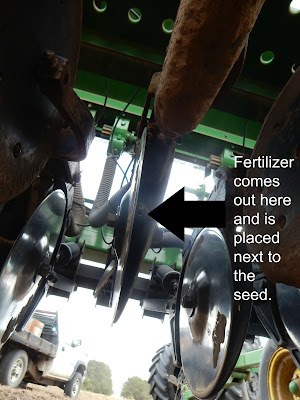

For the past week, Ricky has been working ground with a disc and packers before Randy plants the wheat using a drill.




Once the truck is full, he takes it to the field, where he uses the auger on the grain truck to load the wheat into the drills. He sure thinks it beats shoveling, which he did for a lot of years!

Today, I'll be making a trip to Miller Seed Farms to pick up our certified seed wheat. Our reserved bags of KanMark (a K-State release) and WB 4458 (a WestBred variety) will be used to plant for seed wheat. When we harvest the certified seed next June, it will go in the on-farm bins to be used for seed wheat the next year. And so it goes ...
During those seed stops, Randy also has to fill up the tank with fertilizer.
The starter fertilizer is a combination of nitrogen and phosphate laid down right beside the planted seed. As the seed germinates, its roots seek out the nutrients, establishing a strong root system.
The fertilizer gets transferred from the 1,000-gallon "nurse" tank
pulled by the pickup to this tank on the drill. Then it goes into tubes
...
and is squirted out of small holes in the drill.
As a board member, Randy gets a weekly update from Kansas Wheat. Last Friday, CEO Justin Gilpin concluded with some thoughts about this process that struck home with me and went perfectly with a sunset photo I took of Randy planting.As Randy worked his way toward me one night last week, he turned on his lights. He knows how I like light shining from a tractor or combine as the light fades during a sunset.Peaks and valleys: It’s part of all aspects of life. I encourage my kids to participate as much as possible in sports so that they learn life lessons like dealing with adversity, being a teammate, being accountable, and picking yourself up when you’ve been knocked down.Being a wheat farmer, you guys know all about that. The courage it takes to spend 12-14 hour days, drilling wheat when you know cash price is less than $3 dollars. Sowing seeds when the rewards are 9 months and good fortune away from harvesting. Putting all of your hopes into the weather and “generations of how-best-to” knowledge that has been passed down and learned through past failures. Wheat farming is something special. I hope you all know that the world watches with admiration, and I’m proud of you guys...
So even with a challenging price and no crystal ball for what the weather will bring, the lights are on ... the optimism continues on the County Line. This week, Pastor Nate's sermon was based on Luke 17 and having the faith of a "mustard seed." I think it goes for wheat kernels, too.







Good Luck with winter wheat planting 2016, Miss Kim! I like the thoughts that you shared from Justin Gilpin.
ReplyDeleteThank you, Robyn! We are having our second day of high winds. It's not good on newly-planted wheat. I hope it blows in a little rain.
DeleteLove your photos. I'm doing a presentation and wondered if I could use your photos in my PPT and post.
ReplyDelete